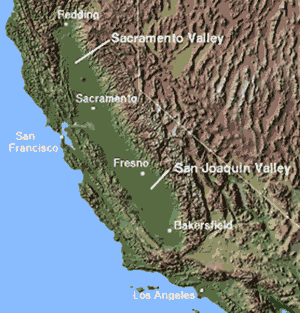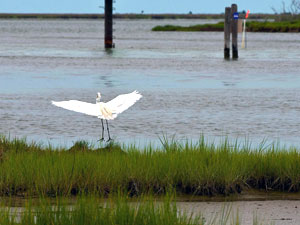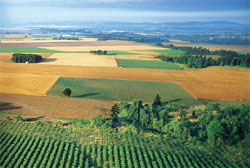Pacific Southwest, Region 9
Serving: Arizona, California, Hawaii, Nevada, Pacific Islands, Tribal Nations
Region 9 Strategic Plan, 2011-14
Geographic Area of Focus: San Joaquin Valley
Sections on this Page
San Joaquin Valley Strategic Plan (PDF) (6 pp, 577K) (Duplicate of the content on this web page.)
Valle de San Joaquín Plan Estratégico (PDF) (6 pp, 152K)
The San Joaquin Valley is California’s top agricultural producing region, growing more than 250 unique crops and much of the Nation’s fruits, vegetables, and nuts. California is the nation’s leading dairy state, with three-quarters of its dairy cows located in the Valley. The annual gross value of agricultural production in the Valley is more than $25 billion.
The Valley owes much of its agricultural success to a remarkable water storage and distribution system that has the federal Central Valley Project at its heart. The Central Valley Project annually distributes roughly four million acre feet of water from the Bay-Delta and San Joaquin River throughout the Valley. Most of this diverted river water is utilized for agriculture, while Valley communities rely mostly on ground water to drink.
The Valley’s extensively managed water systems also support critical wetlands that make the San Joaquin Valley one of the major regions for wintering waterfowl on the Pacific Flyway. The San Joaquin River boasted one of the largest salmon runs on the Pacific Coast before nearly 95% of the river water was diverted for irrigation. Water diversions leave 60 miles of the river to run dry in most years and have left little water for the Valley’s remaining wetlands.

Combined with its unique topography and wind patterns, the Valley’s successes have resulted in severe impacts to the health of its more than four million residents. The San Joaquin Valley is the home of the worst air quality in the country and has some of the highest rates of childhood asthma in California. Transportation, especially trucks, is the largest source of air pollution in the Valley. In addition, water system noncompliance with federal and state drinking water requirements disproportionately affects disadvantaged communities and small systems in San Joaquin Valley. Of the 2,354 community water systems in California that serve 3,300 or fewer persons, 568 reside in the San Joaquin Valley of which 25% violate one or more health based drinking water standards, including arsenic and nitrate. Statewide, only 10% of small water systems violate one or more health based drinking water standards. Many of these systems serve economically disadvantaged communities, do not enjoy the economies of scale larger systems do, and need assistance in developing the technical, managerial and financial capacity necessary to address their noncompliance.
The Valley has some of the highest rates of poverty and unemployment (more than 16% in Fresno County in December 2011) in California. Job needs in the Valley are unique in that the economy is almost wholly driven by agriculture. High Speed Rail development, if approved, could bring a significant number of new jobs to the Valley, many of them green jobs.
The following principles will guide EPA’s work in the San Joaquin Valley.
Environmental Justice
Environmental justice will be considered in regulatory actions that impact the Valley. We will ensure that EPA permitting, oversight, clean up, and risk assessment activities take into consideration, and are responsive to, vulnerable communities. We will also increase the transparency of the work of EPA and its partners, improve our responsiveness to community concerns, and increase community input into policymaking and regulatory actions.
Partnerships
We will strive to effectively join with our federal, state, and local partners and challenge ourselves to better focus our collective resources to improve the quality of life in the San Joaquin Valley. We will also convene local and private partners to tap their expertise and resources, as well as work closely with tribal governments, environmental organizations and community groups to address environmental challenges.
Enforcement
In addition to aggressively using our oversight responsibilities to ensure environmental and health standards can be met in the Valley, we will enhance inspection and enforcement. We will also increase public engagement by helping communities better understand federal, state and local roles in environmental rules, permitting, planning, and enforcement.
The EPA work outlined in this plan represents the highest cross-cutting priorities in the Valley for 2012, and is a subset of EPA’s Valley work.
Air
In partnership with the California Air Resources Board (CARB) and the San Joaquin Valley Air Pollution Control District (SJVAPCD), we will reduce PM 2.5 annual concentrations by 7% per year through regulatory action and accelerating the development of cleaner transportation. Achieve a total reduction of 34% from 2009 levels to reach attainment of PM 2.5 (fine particle matter) standards by the end of 2014. CARB predicts that on average 640 PM-related premature deaths will be avoided per year in San Joaquin Valley if the annual PM 2.5 standard is attained.
- Reduce emissions by working with CARB and the SJVAPCD to develop comprehensive plans for attaining the 2006 24-hour PM 2.5 standard and the .075 ppm (parts per million) 8-hour ozone standard as early as possible. The PM 2.5 plan is due to EPA by December 2012.
- Act on at least 10 San Joaquin Valley rules that will help obtain air emission reductions, including those regarding CAA section 185 nonattainment area fees, fumigants, and petroleum production and distribution.
- Convene government agencies and private companies in Bakersfield to accelerate the development and adoption of cleaner technology, including medium-duty battery-electric and hybrid trucks and vehicles.
Water
Support efforts to address drinking water issues and work to restore the fish and wildlife habitat of the San Joaquin River.
- California Department of Public Health (CDPH) and EPA will address by September 30, 2012, through formal enforcement or other appropriate means, all 28 community water systems in the San Joaquin Valley that are in significant noncompliance with federal and state drinking water requirements.
- Work with other federal agencies (U.S. Department of Agriculture, U.S. Department of Housing and Urban Development) to leverage CDPH planning/design funding for 11 public water systems and construction funding for 4 public water systems that need infrastructure improvements and treatment to meet drinking water standards.
- Work with the State Water Resources Control Board, Regional Boards, CDPH, and other parties to implement the recommendations that will be released this year as a part of the Nitrates Project required by California Water Code Section 83002.5 to reduce problems associated with nitrate contamination in the Tulare Lake Basin and Salinas Valley.
- Award a $15,000 grant to California State University Fresno to support stakeholder forums for identifying regional solutions to water and wastewater challenges in rural communities.
- Update regulations to reduce toxic selenium by issuing draft criteria for selenium in the Bay Delta Estuary.
- Sponsor a public forum in February 2012 to further an integrated surface water quality monitoring and assessment program for the San Joaquin River basin to help target efforts to improve water quality and restore aquatic habitat and species.
Communities

Engage with ongoing federal, state, local, and community-driven efforts to invest in the equitable and sustainable development of the San Joaquin Valley
- Contribute two full time federal employees to lead a multi-agency federal team to pilot the President's Strong Cities, Strong Communities (SC2) initiative in Fresno and partner with the City and local stakeholders to support the implementation of the City's downtown redevelopment plan and economic development vision, which is centered on intensifying downtown development.
- Support more livable and vibrant communities that are environmentally and economically sustainable through reviewing the Final Environmental Impact Statements for the San Joaquin Valley portions of High Speed Rail and the station area development plans for Fresno and Merced. Coordinate technical assistance on a variety of sustainable planning, green building, energy and aquatic resource issues. The California High Speed Rail Authority estimates that the California High Speed Rail System will result in a reduction of 5.8 million barrels of oil being used annually, and will reduce over 1000 tons of NOx and over 90 tons of PM 2.5 emissions on an annual basis in the San Joaquin Valley Region during operation.
- Partner with Greenaction for Health and Environmental Justice to provide educational outreach to 1,000 Kettlemen City and Avenal residents on diesel emissions and health, educate at least 75 truck and bus drivers about diesel health issues and the laws regarding idling of diesel vehicles, secure at least 5 agreements from businesses that use diesel vehicles to educate truckers about reducing idling, and develop a bilingual community guide for how to implement a diesel education and emission reduction program.
- Partner with Community Water Center to provide technical and educational assistance to at least 20 small rural communities in Tulare, Kern, Kings and Fresno Counties about drinking water pollution and facilitate meaningful participation of community members in public processes related to decisions on accessibility and safety of their drinking water
- Build community capacity to address environmental impacts by partnering with Californians for Pesticide Reform to build a web-based real time system to monitor, track, and address environmental health hazards and improve children's health outcomes in Tulare and Kern counties and provide technical assistance to the South Kern community and the California Endowment to implement action plans that will improve air and water quality, and reduce the risk from pesticides.
- Work with Fresno Youth Council's Brownfield to Urban Garden project to identify a potential site for a community garden in Southwest Fresno and to assess the site to ensure it is safe for gardening by September. Afterwards, facilitate a community-based process, including helping to secure partners, in order to design and plan the construction of the community garden.
- Support 9 existing assessment or clean-up Brownfield Grants in the San Joaquin Valley, including a Brownfields Workforce Development Grant in Tulare that trains students to safely clean-up hazardous materials in buildings and in soil to prepare them for jobs in local government, utilities and private firms. The City of Tulare will train and find employment for approximately 15 students with the help of their partner agencies.
- Partner with the City of Fresno, other federal agencies, community health centers, and housing assistance programs to launch a Weatherization plus Health pilot program in Fresno County that will upgrade homes to improve the health of asthmatic occupants and to reduce energy use.
Agriculture

Agriculture in the San Joaquin Valley
Reduce the environmental impacts of Valley animal and crop agriculture. The activities listed below are only a subset of Region 9’s work related to agriculture
- To protect agricultural workers from improper application of pesticides, oversee state inspection and enforcement programs to ensure that the numbers of people impacted by high level episodes are reduced by 10% in 2012 from 2009 levels. High level episodes are incidents that involve illness or serious injury to 5 or more people.
- To produce renewable energy and reduce greenhouse gases, help two additional dairy digesters come on line in California by promoting and implementing the policy recommendations of the state and federal working group that EPA, USDA, and CDFA are convening to address the barriers of digester implementation.
- Develop partnerships to provide equipment and technical assistance to support adoption of conservation tillage, resulting in 5 additional growers experimenting with conservation tillage practices.
- Work with California Air Districts and industry partners in 2011 to coordinate funding for replacement or retrofit of about 300 agricultural engines to reduce at least 5 tons of PM 2.5, 74 tons of NOx, and 11,000 tons of CO2 on an annual basis.
- Work with SJVAPCD, CARB, and USDA to develop a framework to ensure that emission reductions from incentive programs that meet EPA's criteria could be fully credited in SIPs. Such programs could include, for example, about $18 million that USDA made available in 2011 for agricultural engine retrofits which reduced about 450 tons of NOx on an annual basis.
- Organize a pesticide container recycling project with the goal of recycling at least 250 pesticide containers and 18,000 lbs. of plastic.
Communications
Increase transparency, accountability, and support for the Valley work outlined in EPA’s San Joaquin Valley Strategic Plan through enhanced outreach and communication with the public, media, and decision-makers.
- Support and promote initiatives for the Valley by our federal, state, and local partners.
- Convene a public event to showcase and promote the deployment of cutting-edge technologies needed to clean up the air from large emission sources, including diesel.
